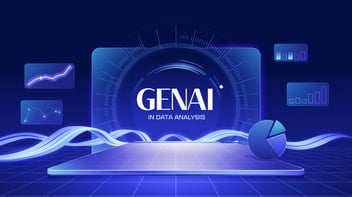Introduction
In today’s era of industrial evolution, Big Data is not just a buzzword—it's a game-changer. The manufacturing sector, traditionally driven by mechanical precision and process discipline, is undergoing a digital renaissance. As industries strive to become more agile, responsive, and efficient, smart manufacturing powered by data analytics is emerging as the keystone of competitive advantage. From enabling real-time process optimization to predictive maintenance in manufacturing and supply chain enhancements, Big Data in manufacturing is unlocking new levels of innovation and productivity.
This article delves into how manufacturers embrace intelligent manufacturing through analytics, the tangible benefits achieved, and the critical hurdles encountered along the way. With a strategic outlook and practical insights, we unpack what it truly means to transform manufacturing with Big Data.
Understanding Big Data in the Context of Manufacturing
Big Data refers to the massive volume of structured and unstructured data generated from diverse sources—machines, IoT sensors, supply chain systems, ERP platforms, MES solutions, CRM tools, and even customer feedback channels. These datasets are characterized by high volume, velocity, variety, and veracity—the "4 Vs" that defines Big Data. In the context of manufacturing, this means continuous streams of data from assembly lines, logistics networks, vendor databases, and field operations.
When harnessed effectively through manufacturing analytics, this data becomes an invaluable resource for driving operational improvements, enhancing agility, and making smarter decisions. It enables manufacturers to move from reactive to proactive operations, uncovering patterns and predicting outcomes that were previously obscured by data silos or lack of analytical capability. (
IBM)
Key Benefits of Big Data in Manufacturing
1. Enhanced Operational Efficiency
Manufacturers can achieve significant performance gains by analyzing real-time production data and identifying inefficiencies:
-
Real-time machine monitoring reduces unplanned downtime by enabling proactive adjustments based on current performance metrics.
-
Predictive analytics for maintenance use historical and real-time data to anticipate equipment failures, minimizing disruptions and extending machinery lifespan.
-
Workflow optimization becomes achievable as manufacturers analyze bottlenecks and resource allocation issues to streamline production lines.
2. Improved Decision-Making Processes
Big Data analytics enhances both strategic and operational decision-making:
-
Scenario modeling tools empower teams to simulate various production strategies and evaluate their outcomes before full-scale implementation.
-
Customer trend analysis ensures product development aligns with market demands and shifting preferences.
-
Data-driven decision-making reduces reliance on outdated practices or gut instincts, fostering a culture of continuous improvement.
Challenges in Implementing Big Data Solutions
Despite the compelling benefits, integrating Big Data into manufacturing ecosystems comes with its own set of challenges.
1. Data Integration Complexities
Manufacturing environments often operate with siloed and legacy systems, including
ERP,
MES, and
CRM platforms:
-
Inconsistent data formats and poor interoperability lead to fragmented insights and decision-making inefficiencies.
-
The absence of a unified data platform prevents organizations from obtaining a comprehensive, real-time operational view.
2. Security and Privacy Risks
With increased data dependence comes heightened vulnerability to cyber threats:
-
Protecting sensitive production and customer data is crucial to avoiding reputational damage and regulatory penalties.
-
Implementing robust cybersecurity protocols including data encryption, identity access management, and regular audits is essential. (NIST)
Real-World Applications: Big Data Analytics in Manufacturing
1. Predictive Maintenance in Automotive Manufacturing
A prominent automotive manufacturer integrated IoT sensors across its production lines to
monitor equipment conditions in real-time. By analyzing data on temperature, vibration, and machine cycles, they optimized maintenance schedules and minimized unexpected failures.
While specific metrics may vary by use case, numerous industry reports highlight significant reductions in downtime and maintenance costs through predictive analytics. (
McKinsey)2. Quality Control in Food Processing
Though exact spoilage reduction figures depend on operational scale and analytics maturity, industry success stories demonstrate measurable improvements in product consistency and waste reduction.
3. Supply Chain Optimization in Electronics Manufacturing
Electronics manufacturers use Big Data to
synchronize demand forecasting with procurement, logistics, and production planning. Real-time analytics on inventory levels, supplier performance, and order status enables faster response times and leaner operations.
The Role of IoT and Cloud in Big Data Implementation
Internet of Things (IoT) and cloud computing are foundational to smart manufacturing initiatives:
-
IoT sensors embedded in machinery capture granular performance metrics in real time, feeding analytics platforms with accurate, timely data. These sensors can detect micro-level anomalies that human operators might miss, enabling automated alerts and corrective actions.
-
Cloud platforms provide scalability, flexibility, and remote accessibility. Manufacturers can store, process, and analyze vast datasets without investing heavily in on-premises infrastructure. This also facilitates real-time collaboration across global teams, enhancing coordination and transparency.
Best Practices for Big Data Adoption in Manufacturing
1. Define Clear Objectives
Successful Big Data initiatives begin with well-defined goals:
- Whether aiming to reduce costs, increase throughput, or boost customer satisfaction, aligning analytics with strategic objectives ensures relevance and measurable impact.
2. Invest in Scalable Infrastructure
- Adopt cloud-based tools and modular analytics platforms that grow with your operations.
- Flexibility ensures easy integration with emerging technologies like AI and machine learning.
3. Build Cross-Functional Teams
- Encourage collaboration between IT, operations, quality control, and data science teams.
- Cross-disciplinary synergy enables identification of the most impactful analytics opportunities and supports seamless execution.
Conclusion: The Data-Powered Future of Manufacturing
As manufacturing enters a new age, data is no longer a byproduct—it's the engine. The transition to intelligent, data-driven operations holds the key to unlocking next-level efficiency, agility, and customer-centricity. From the shop floor to the supply chain, Big Data in manufacturing is shaping a smarter, faster, and more resilient industrial future.
But transformation doesn't happen overnight. It demands a proactive approach to system integration, robust data governance, and an unwavering focus on clear business outcomes. By investing in
predictive maintenance, smart manufacturing systems, and secure data frameworks, manufacturers can convert information into insight—and insight into impact.
The future of manufacturing is not just digital. It's intelligent, connected, and data-empowered. The question isn't whether to embrace Big Data, but how quickly you can begin.
Empowering Manufacturing with AI – Pacific Data Integrators (PDI)
The integration of AI and advanced automation in manufacturing can be complex, but with Pacific Data Integrators (PDI), it becomes a seamless transformation. Our expertise ensures a smooth AI adoption journey, optimizing efficiency, reducing downtime, and driving innovation. Partner with PDI to unlock the full potential of AI-powered manufacturing solutions tailored to your business needs.
Consult with our experts today and take the next step toward intelligent manufacturing.
Book a consultation now at PDI.
Blog Post by PDI Marketing Team
Pacific Data Integrators Offers Unique Data Solutions Leveraging AI/ML, Large Language Models (Open AI: GPT-4, Meta: Llama2, Databricks: Dolly), Cloud, Data Management and Analytics Technologies, Helping Leading Organizations Solve Their Critical Business Challenges, Drive Data Driven Insights, Improve Decision-Making, and Achieve Business Objectives.






